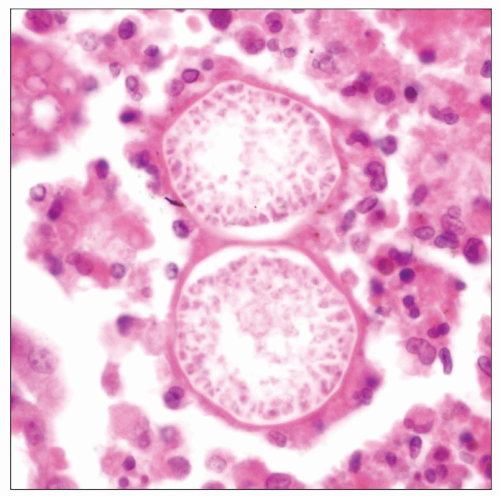Coccidioidomycosis
Key Facts
Terminology
Pulmonary infection caused by inhalation of fungal spores of Coccidioides immitis
Clinical Issues
Organism is endemic in Southwestern United States, Mexico, and Central and South America
Pulmonary infection may be acute, persistent, or chronic
Chronic progressive infection can mimic tuberculosis with miliary dissemination and high mortality
Solitary cavitary nodules with thin walls may be seen in upper lobes in up to 70% of cases
Extrapulmonary dissemination can occur in pregnant women and immunosuppressed patients
Microscopic Pathology
Primary pulmonary infection is characterized by an acute suppurative pneumonia with neutrophilic infiltrates
Granulomatous lesions are characterized by solid epithelioid granulomas that can cavitate and undergo central necrosis
Organism is characterized by a large, round to oval spherule (30-100 µm) containing multiple endospores
Immature spherules lack endospores
Ancillary Tests
GMS stains both mature spherules and endospores
Immature spherules are PAS positive
 Cut surface of the lung in a patient with cavitary lesions due to coccidioidomycosis shows large, thin-walled subpleural cavities lined by fibrous tissue with necrotic debris. |
TERMINOLOGY
Synonyms
San Joaquin Valley fever
Definitions
Pulmonary infection caused by inhalation of fungal spores of Coccidioides immitis
ETIOLOGY/PATHOGENESIS
Environmental Exposure
Organisms preferentially grow in hot, dry, or semi-arid climates (e.g., desert)
CLINICAL ISSUES
Epidemiology
Incidence
Organism is endemic in Southwestern United States, Mexico, and Central and South America
Presentation
Majority of patients are asymptomatic
Symptomatic patients present with
Fever with influenza-like illness
Cough
Myalgias and arthralgias
Pleuritic pain
Erythema nodosum or erythema multiforme (in 20% of patients)
Laboratory Tests
Serum IgM antibodies to C. immitis can be detected 2-3 weeks after onset of infection in 75% of patients
Serum IgG antibodies are detected in later stages in up to 90% of patients
Natural History
Pulmonary infection may be acute, persistent, or chronic
Acute infection develops 1-4 weeks following inhalation of spores and leads to fungal pneumonia
Chronic progressive infection can mimic tuberculosis with miliary dissemination and high mortality
Residual localized pulmonary nodule (coccidioidoma) can be seen as a sequel of resolved primary infection
Solitary cavitary nodules with thin walls may be seen in upper lobes in up to 70% of cases
Extrapulmonary dissemination can occur in pregnant women and immunosuppressed patients
Treatment
Drugs
Amphotericin B
Prognosis
Most patients recover spontaneously without evidence of persistent disease
Persistent pneumonia in immunosuppressed patients can be fatal and requires antifungal treatment




